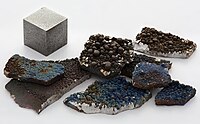
Photo from wikipedia
MnO2 nanoparticles, similar to those found in soils and sediments, have been characterized via their UV-visible and Raman spectra, combined with dynamic light scattering and reactivity measurements. Synthetic colloids were… Click to show full abstract
MnO2 nanoparticles, similar to those found in soils and sediments, have been characterized via their UV-visible and Raman spectra, combined with dynamic light scattering and reactivity measurements. Synthetic colloids were prepared by thiosulfate reduction of permanganate, their sizes controlled with adsorbates acting as capping agents: bicarbonate, phosphate, and pyrophosphate. Biogenic colloids, products of the manganese oxidase, Mnx, were similarly characterized. The band-gap energies of the colloids were found to increase with decreasing hydrodynamic diameter, Dh, and were proportional to 1/ Dh2, as predicted from quantum confinement theory. The intensity ratio of the two prominent Mn-O stretching Raman bands also varied with particle size, consistent with the ratio of edge to bulk Mn atoms. Reactivity of the synthetic colloids toward reduction by Mn2+, in the presence of pyrophosphate to trap the Mn3+ product, was proportional to the surface to volume ratio, but showed surprising complexity. There was also a remnant unreactive fraction, likely attributable to Mn(III)-induced surface passivation. The band gap was similar for biogenic and synthetic colloids of similar size, but decreased when the enzyme solution contained pyrophosphate, which traps the intermediate Mn(III) and slows MnO2 growth. The band gap/size correlation was used to analyze the growth of the enzymatically produced MnO2 oxides.
Journal Title: Environmental science & technology
Year Published: 2019
Link to full text (if available)
Share on Social Media: Sign Up to like & get
recommendations!